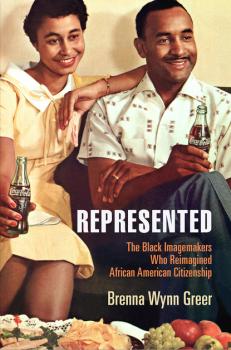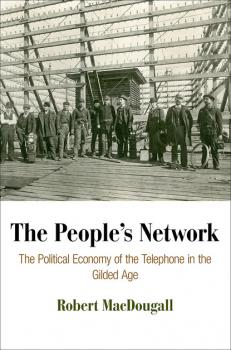American Business, Politics, and Society
Скачать книги из серии American Business, Politics, and SocietyRepresented
In 1948, Moss Kendrix, a former New Deal public relations officer, founded a highly successful, Washington, D.C.-based public relations firm, the flagship client of which was the Coca-Cola Company. As the first black pitchman for Coca-Cola, Kendrix found his way into the rarefied world of white corporate America. His personal phone book also included the names of countless black celebrities, such as bandleader Duke Ellington, singer-actress Pearl Bailey, and boxer Joe Louis, with whom he had built relationships in the course of developing marketing campaigns for his numerous federal and corporate clients. Kendrix, along with Ebony publisher John H. Johnson and Life photographer Gordon Parks, recognized that, in the image-saturated world of postwar America, media in all its forms held greater significance for defining American citizenship than ever before. For these imagemakers, the visual representation of African Americans as good citizens was good business. In Represented , Brenna Wynn Greer explores how black entrepreneurs produced magazines, photographs, and advertising that forged a close association between blackness and Americanness. In particular, they popularized conceptions of African Americans as enthusiastic consumers, a status essential to postwar citizenship claims. But their media creations were complicated: subject to marketplace dictates, they often relied on gender, class, and family stereotypes. Demand for such representations came not only from corporate and government clients to fuel mass consumerism and attract support for national efforts, such as the fight against fascism, but also from African Americans who sought depictions of blackness to counter racist ideas that undermined their rights and their national belonging as citizens. The story of how black capitalists made the market work for racial progress on their way to making money reminds us that the path to civil rights involved commercial endeavors as well as social and political activism.
Market Rules
Although most Americans attribute shifting practices in the financial industry to the invisible hand of the market, Mark H. Rose reveals the degree to which presidents, legislators, regulators, and even bankers themselves have long taken an active interest in regulating the industry. In 1971, members of Richard Nixon's Commission on Financial Structure and Regulation described the banks they sought to create as «supermarkets.» Analogous to the twentieth-century model of a store at which Americans could buy everything from soft drinks to fresh produce, supermarket banks would accept deposits, make loans, sell insurance, guide mergers and acquisitions, and underwrite stock and bond issues. The supermarket bank presented a radical departure from the financial industry as it stood, composed as it was of local savings and loans, commercial banks, investment banks, mutual funds, and insurance firms. Over the next four decades, through a process Rose describes as «grinding politics,» supermarket banks became the guiding model of the financial industry. As the banking industry consolidated, it grew too large while remaining too fragmented and unwieldy for politicians to regulate and for regulators to understand—until, in 2008, those supermarket banks, such as Citigroup, needed federal help to survive and prosper once again. Rose explains the history of the financial industry as a story of individuals—some well-known, like Presidents Kennedy, Carter, Reagan, and Clinton; Treasury Secretaries Donald Regan and Timothy Geithner; and JP Morgan CEO Jamie Dimon; and some less so, though equally influential, such as Kennedy's Comptroller of the Currency James J. Saxon, Citicorp CEO Walter Wriston, and Bank of America CEOs Hugh McColl and Kenneth Lewis. Rose traces the evolution of supermarket banks from the early days of the Kennedy administration, through the financial crisis of 2008, and up to the Trump administration's attempts to modify bank rules. Deeply researched and accessibly written, Market Rules demystifies the major trends in the banking industry and brings financial policy to life.
Risk and Ruin
At the time of its collapse in 2001, Enron was one of the largest companies in the world, boasting revenue of over $100 billion. During the 1990s economic boom, the Houston, Texas-based energy company had diversified into commodities and derivatives trading and many other ventures—some more legal than others. In the lead-up to Enron's demise, it was revealed that the company's financial success was sustained by a creatively planned and well-orchestrated accounting fraud. The story of Enron and its disastrous aftermath has since become a symbol of corporate excess and negligence, framed as an exceptional event in the annals of American business. With Risk and Ruin , Gavin Benke places Enron's fall within the larger history and culture of late twentieth-century American capitalism. In many ways, Benke argues, Enron was emblematic of the transitions that characterized the era. Like Enron, the American economy had shifted from old industry to the so-called knowledge economy, from goods to finance, and from national to global modes of production. Benke dives deep into the Enron archives, analyzing company newsletters, board meeting minutes, and courtroom transcriptions to chart several interconnected themes across Enron's history: the changing fortunes of Houston; the shifting attitudes toward business strategy, deregulation, and the function of the market among policy makers and business leaders; and the cultural context that accompanied and encouraged these broader political and economic changes. Considered against this backdrop, Enron takes on new significance as a potent reminder of the unaddressed issues still facing national and global economies. Published in cooperation with the William P. Clements Center for Southwest Studies at Southern Methodist University.
The People's Network
The Bell System dominated telecommunications in the United States and Canada for most of the twentieth century, but its monopoly was not inevitable. In the decades around 1900, ordinary citizens—farmers, doctors, small-town entrepreneurs—established tens of thousands of independent telephone systems, stringing their own wires to bring this new technology to the people. Managed by opportunists and idealists alike, these small businesses were motivated not only by profit but also by the promise of open communication as a weapon against monopoly capital and for protection of regional autonomy. As the Bell empire grew, independents fought fiercely to retain control of their local networks and companies—a struggle with an emerging corporate giant that has been almost entirely forgotten. The People's Network reconstructs the story of the telephone's contentious beginnings, exploring the interplay of political economy, business strategy, and social practice in the creation of modern North American telecommunications. Drawing from government documents in the United States and Canada, independent telephone journals and publications, and the archives of regional Bell operating companies and their rivals, Robert MacDougall locates the national debates over the meaning, use, and organization of the telephone industry as a turning point in the history of information networks. The competing businesses represented dueling political philosophies: regional versus national identity and local versus centralized power. Although independent telephone companies did not win their fight with big business, they fundamentally changed the way telecommunications were conceived.
The Pennsylvania Railroad, Volume 1
"Do not think of the Pennsylvania Railroad as a business enterprise," Forbes magazine informed its readers in May 1936. «Think of it as a nation.» At the end of the nineteenth century, the Pennsylvania Railroad was the largest privately owned business corporation in the world. In 1914, the PRR employed more than two hundred thousand people—more than double the number of soldiers in the United States Army. As the self-proclaimed «Standard Railroad of the World,» this colossal corporate body underwrote American industrial expansion and shaped the economic, political, and social environment of the United States. In turn, the PRR was fundamentally shaped by the American landscape, adapting to geography as well as shifts in competitive economics and public policy. Albert J. Churella's masterful account, certain to become the authoritative history of the Pennsylvania Railroad, illuminates broad themes in American history, from the development of managerial practices and labor relations to the relationship between business and government to advances in technology and transportation. Churella situates exhaustive archival research on the Pennsylvania Railroad within the social, economic, and technological changes of nineteenth- and twentieth-century America, chronicling the epic history of the PRR intertwined with that of a developing nation. This first volume opens with the development of the Main Line of Public Works, devised by Pennsylvanians in the 1820s to compete with the Erie Canal. Though a public rather than a private enterprise, the Main Line foreshadowed the establishment of the Pennsylvania Railroad in 1846. Over the next decades, as the nation weathered the Civil War, industrial expansion, and labor unrest, the PRR expanded despite competition with rival railroads and disputes with such figures as Andrew Carnegie and John D. Rockefeller. The dawn of the twentieth century brought a measure of stability to the railroad industry, enabling the creation of such architectural monuments as Pennsylvania Station in New York City. The volume closes at the threshold of American involvement in World War I, as the strategies that PRR executives had perfected in previous decades proved less effective at guiding the company through increasingly tumultuous economic and political waters.
Making Seafood Sustainable
In the spring of 2007, National Geographic warned, «The oceans are in deep blue trouble. From the northernmost reaches of the Greenland Sea to the swirl of the Antarctic Circle, we are gutting our seas of fish.» There were legitimate grounds for concern. After increasing more than fourfold between 1950 and 1994, the global wild fish catch reached a plateau and stagnated despite exponential growth in the fishing industry. As numerous scientific reports showed, many fish stocks around the world collapsed, creating a genuine global overfishing crisis. Making Seafood Sustainable analyzes the ramifications of overfishing for the United States by investigating how fishers, seafood processors, retailers, government officials, and others have worked together to respond to the crisis. Historian Mansel G. Blackford examines how these players took steps to make fishing in some American waters, especially in Alaskan waters, sustainable. Critical to these efforts, Blackford argues, has been government and industry collaboration in formulating and enforcing regulations. What can be learned from these successful experiences? Are they applicable elsewhere? What are the drawbacks? Making Seafood Sustainable addresses these questions and suggests that sustainable seafood management can be made to work. The economic and social costs incurred in achieving sustainable resource usage are significant, but there are ways to mitigate them. More broadly, this study illustrates ways to manage commonly held natural resources around the world—land, water, oil, and so on—in sustainable ways.
Hinterland Dreams
In the 1840s, La Crosse, Wisconsin, was barely more than a trading post nestled on the banks of the Mississippi River. But by 1900 the sleepy frontier town had become a thriving city. Hinterland Dreams tracks the growth of this community and shows that government institutions and policies were as important as landscapes and urban boosters in determining the small Midwestern city's success. The businessmen and -women of La Crosse worked hard to attract government support during the nineteenth century. Federal, state, and municipal officials passed laws, issued rulings, provided resources, vested aldermen with financial and regulatory power, and created a lasting legal foundation that transformed the city and its economy. As historian Eric J. Morser demonstrates, the development of La Crosse and other small cities linked rural people to the wider world and provided large cities like Chicago with the lumber and other raw materials needed to grow even larger. He emphasizes the role of these municipalities, as well as their relationship to all levels of government, in the life of an industrializing nation. Punctuated with intriguing portraits of La Crosse's early citizens, Hinterland Dreams suggests a new way to understand the Midwest's urban past, one that has its roots in the small but vibrant cities that dotted the landscape. By mapping the richly textured political economy of La Crosse before 1900, the book highlights how the American state provided hinterland Midwesterners with potent tools to build cities and help define their region's history in profound and lasting ways.
Sound Business
American newspapers have faced competition from new media for over ninety years. Today digital media challenge the printed word. In the 1920s, broadcast radio was the threatening upstart. At the time, newspaper publishers of all sizes turned threat into opportunity by establishing their own stations. Many, such as the Chicago Tribune 's WGN, are still in operation. By 1940 newspapers owned 30 percent of America's radio stations. This new type of enterprise, the multimedia corporation, troubled those who feared its power to control the flow of news and information. In Sound Business , historian Michael Stamm traces how these corporations and their critics reshaped the ways Americans received the news. Stamm is attuned to a neglected aspect of U.S. media history: the role newspaper owners played in communications from the dawn of radio to the rise of television. Drawing on a wide array of primary sources, he recounts the controversies surrounding joint newspaper and radio operations. These companies capitalized on synergies between print and broadcast production. As their advertising revenue grew, so did concern over their concentrated influence. Federal policymakers, especially during the New Deal, responded to widespread concerns about the consequences of media consolidation by seeking to limit and even ban cross ownership. The debates between corporations, policymakers, and critics over how to regulate these new kinds of media businesses ultimately structured the channels of information distribution in the United States and determined who would control the institutions undergirding American society and politics. Sound Business is a timely examination of the connections between media ownership, content, and distribution, one that both expands our understanding of mid-twentieth-century America and offers lessons for the digital age.
Sovereign Soldiers
They helped conquer the greatest armies ever assembled. Yet no sooner had they tasted victory after World War II than American generals suddenly found themselves governing their former enemies, devising domestic policy and making critical economic decisions for people they had just defeated in battle. In postwar Germany and Japan, this authority fell into the hands of Dwight D. Eisenhower and Douglas MacArthur, along with a cadre of military officials like Lucius Clay and the Detroit banker Joseph Dodge. In Sovereign Soldiers , Grant Madsen tells the story of how this cast of characters assumed an unfamiliar and often untold policymaking role. Seeking to avoid the harsh punishments meted out after World War I, military leaders believed they had to rebuild and rehabilitate their former enemies; if they failed they might cause an even deadlier World War III. Although they knew economic recovery would be critical in their effort, none was schooled in economics. Beyond their hopes, they managed to rebuild not only their former enemies but the entire western economy during the early Cold War. Madsen shows how army leaders learned from the people they governed, drawing expertise that they ultimately brought back to the United States during the Eisenhower Administration in 1953. Sovereign Soldiers thus traces the circulation of economic ideas around the globe and back to the United States, with the American military at the helm.









